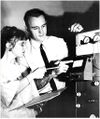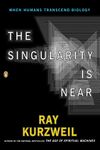History of transhumanism
The history of transhumanism is complicated and relatively poorly documented prior to the internet age. However the dynamics of the movement are accelerating in recent years as more people are drawn to it without a strong sense of history.
Sources[править]
The following main sources were used in compiling this list:
- A Timeline of Transhumanism on The Verge, 2015
- A history of transhumanist thought (PDF) - written by Nick Bostrom, 2005
- Teilhard de Chardin and Transhumanism - written by Eric Steinhart, 2008
Additional notable events have been added as necessary.
Yet to be integrated:
Timeline[править]
Prehistory[править]
1900 to 1940's precursors[править]

- 1906 - Nikolai Fyodorov establishes Russian cosmism, a spiritual belief system and precursor to transhumanism which advocates for physical immortality, space exploration, and resurrecting the dead through science.
- 1923 - British scientist and Marxist J. B. S. Haldane publishes Daedalus; or, Science and the Future which offers an early vision of transhumanist thought, particularly concerned with the ethical implications of the advancement of science. He also commented on what has in recent years become known as the "yuck factor"[1]

- 1929 - British scientist John Desmond Bernal publishes The World, the Flesh and the Devil, introducing ideas central to transhumanism including liveable space habitats, and the future changes science could bring to human intelligence and physicality.
- 1931 - Amazing Stories publishes "The Jameson Satellite", a short story by Neil R. Jones, about a man whose corpse is sent into orbit, where it remains near absolute zero for millions of years until a race of cyborgs discovers it, defrosts its brain, and installs it in a robot's body.
- 1932 - Brave New World is published by Aldous Huxley, brother of Julian Huxley, describing a transhumanist dystopia where psychological conditioning, promiscuous sexuality, biotechnology, and the opiate drug "soma" keep the population placid in a static, conformist caste society[1]

- 1935-6 - The French technocrat Jean Coutrot uses the word "transhumanisme" in writings in the French language[2][3]
- 1940 - W. D. Lighthall is the first person known to use the word 'transhumanism' in the English language. He writes of '[St] Paul's Transhumanism' possibly in a homage to a 'transhuman change', a heavenwards journey featured in the 1814 English translation of Dante’s Divine Comedy.[4][5]
- 1945 - The reaction to the Holocaust where over 6 million Jews and other groups undesirable to the Nazi regime were systemically killed mostly marks the end of western affinity for eugenics and similar programmes[1]
- 1945 - Vannevar Bush publishes As We May Think in The Atlantic,[6] detailing the concept of a memex and laying out an early vision of an information society enabled by hypertext and collective memory.
- 1948 - Inspired by "The Jameson Satellite" cryonics founder Robert Ettinger publishes his short story "The Penultimate Trump," in Startling Stories. In it, Ettinger proposes cryonics as "one-way medical time travel to the future."
- 1949 - Pierre Teilhard de Chardin, philosopher and Jesuit priest, paleontologist and geologist who coined the term Omega Point writes of man 'trans-humanizing' himself[7]
1950's to 1970's[править]

- 1951 - Noted eugenicist and evolutionary biologist Julian Huxley uses the term "transhumanism" in a lecture delivered in Washington DC titled Knowledge, Morality and Destiny. Huxley describes his philosophy as "the idea of humanity attempting to overcome its limitations and to arrive at fuller fruition."[8]
- 1954 - Jerry Sohl publishes his sci-fi story "The Altered Ego," in which a man is able to make a digital duplicate of his mind and access it after his death. This marks the first appearance of mind-uploading in fiction.
- 1957 - "The word “transhumanism” first gained significant recognition when used by Julian Huxley, a distinguished biologist (who was also the first director‐general of UNESCO and a founder of the World Wildlife Fund). In his second edition Religion Without Revelation (1957), he wrote:
The human species can, if it wishes, transcend itself – not just sporadically, an individual here in one way, an individual there in another way – but in its entirety, as humanity. We need a name for this new belief. Perhaps transhumanism will serve: man remaining man, but transcending himself, by realizing new possibilities of and for his human nature"[1]
- 1959 - Physicist Richard P. Feynman presents the lecture, There's Plenty of Room at the Bottom, suggesting the possibility of the manipulation of atoms in synthetic chemistry. The lecture will later inspire the field of nanotechnology.
- 1964 - Robert Ettinger publishes "The Prospect of Immortality," a manifesto for cryonics. A small number of cryonics societies are established across the US.

- 1965 - Cryptographer and computer scientist Irving John Good publishes "Speculations Concerning the First Ultraintelligent Machine," the first proposal for a possible future intelligence explosion in machine learning.
- 1967 - Philosopher Harry Overstreet make the first mention "extropy" — the attempt to counteract the natural law of entropy — in a 1967 volume of the journal, Physis.
- 1967 - The first person is cryogenically frozen at the Cryonics Society of California by the society's president — Robert Nelson, a television repairman. The operation was ultimately deemed unsuccessful and Nelson's clients were "lost."[9]
- 1968 - The Mother of All Demos is presented at the ACM/IEEE Computing Society's Fall Joint Computer Conference by Douglas Engelbart of the Augmentation Research Center, establishing many modern computing concepts.

- 1972 - Fred & Linda Chamberlain establish the Alcor Society for Solid State Hypothermia, later renamed to the Alcor Life Extension Foundation, in Los Angeles. Fred Chamberlain had previously worked as a space program engineer at NASA's Jet Propulsion Laboratory.
- 1972 - Apollo 17 becomes the final manned mission to the Moon.
- 1972 - The Club of Rome publishes The Limits to Growth, positing dire projections of a growing global population and dwindling resources.
- 1973 - FM-2030, then known as Fereidoun M. Esfandiary, publishes Up-Wingers: A Futurist Manifesto.
- 1974 - Physicist Gerard K. O'Neil publishes "The Colonization of Space" in Physics Today. O'Neil advocates "finding high quality living space for a world population that is doubling every 35 years; finding clean, practical energy sources; preventing overload of Earth's heat balance."
- 1975 - The L5 Society is established to continue O'Neil's work advocating for space colonization. Its members include Eric Drexler.
- 1976 - The Cryonics Institute is established and freezes its first clients in liquid nitrogen.
1980's[править]

- 1980 - The L5 Society helps defeat US ratification of the Moon Treaty, paving the way for private space exploration and resource exploitation of celestial bodies.
- 1983 - Natasha Vita-More publishes The Transhuman Manifesto.
- 1984 - The first definitive cyberpunk novel Neuromancer by William Gibson's marks a branching of futurist ideas away from techno-optimism
- 1986 - Partly in response to The Limits to Growth, Eric Drexler, then research affiliate with MIT's Artificial Intelligence Laboratory, publishes Engines of Creation, which proposes the theory of nanotechnology; "‘molecular assemblers,' devices capable of positioning atoms and molecules for precisely defined reactions in almost any environment," as a potential solution to Earth's limited resources.
- 1986 - Eric Drexler and Christine Peterson establish The Foresight Institute to "ensure beneficial implementation of nanotechnology."

- 1986 - The first transhumanist TV show hosted by Natasha Vita-More, TransCentury UPdate airs on US cable TV until the early 90's
- 1987 - The Dora Kent controversy brings cryonics to greater public and legal attention.
- 1988 - The first transhumanist magazine, Extropy: Vaccine for Future Shock, is published by Max More and T.O. Morrow. It is later renamed The Journal of Transhumanist Thought.
- 1989 - FM-2030 publishes the book, Are You A Transhuman?
1990's[править]

- 1990 - Hans Morvac publishes Mind Children, predicting superintelligent robots by 2030.
- 1991 - The Extropians Mailing list[10] is established, the first major online hub for transhumanist ideas to be exchanged. Several prominent writers, theorists, and technologists in the movement regularly post to the boards, which continues to be active today.
- 1993 - Science fiction author, computer scientist, and mathematician Vernor Vinge publishes The Coming Technological Singularity,[11] popularizing the theory of the Singularity and predicting its arrival sometime before 2030.

- 1994 - Ed Regis profiles Max More and T.O. Morrow and others in Wired magazine, "Meet The Extropians"[12]
- 1994 - The first Extropy Institute Conference on Transhumanist Thought is held in Sunnyvale, California.[13]
- 1995 - Peter Diamandis establishes the X Prize[14] to fund "radical breakthroughs for the benefit of humanity." The board of trustees will later include Larry Page and Elon Musk.
- 1995 - David Pearce publishes the first version of The Hedonistic Imperative about how technology may be used to abolish all suffering in sentient life

- 1997 - An updated version of Natasha Vita-More's The Transhuman Manifesto is sent with the Cassini Huygens space probe to Saturn.[15]
- 1997 - The Declaration in Defence of Cloning and the Integrity of Scientific Research is issued.
- 1998 - Philosophers Nick Bostrom founds the World Transhumanist Association with David Pearce. The first iteration of the Transhumanist Declaration is created.
- 1998 - The first ever TransVision[16] conference is held in the Netherlands, a major conferences that would be held most years following.
2000[править]

- Eliezer Yudkowsky founds SIAI,[17] which in 2013 would become MIRI and the Center for Applied Rationality
- The SL4 mailing list is founded
- FM-2030, science fiction author and futurist, enters suspension at Alcor[18]
2001[править]
- James Hughes is elected secretary of the World Transhumanist Association, formalising its structures and begins building up a international network of local groups and volunteers.[1]
2002[править]
2003[править]
- The Methuselah Foundation is founded by David Goebel and Aubrey de Grey to research rejuvanative life extension technologies
2004[править]

- Nick Bostrom and James Hughes establish the Institute for Ethics and Emerging Technologies, which publishes the Journal of Transhumanism
- Hughes publishes Citizen Cyborg and the position of Democratic Transhumanism (a form of technoprogressivism) merging transhumanist and leftist political positions.[1]
- Prominent bioconservative Francis Fukuyama labels transhumanism "The world's most dangerous idea"[19]
- The Transhumanist Cooperative Colloquium was short-lived attempt at a large transhumanist alliance from Natasha Vita-More
2005[править]

- Ray Kurzweil publishes The Singularity is Near
- Nick Bostrom establishes the Future of Humanity Institute, with associates Anders Sandberg and Eric Drexler
2006[править]

- Peter Thiel donates $100,000 to the Machine Intelligence Research Institute and joins its board.[20] Thiel also pledges $3.5 million to the Methuselah Mouse Prize foundation to find a cure for aging.
- The Extropy Institute closes, briefly causing contention over the WTA as a successor
2007[править]
2008[править]

- Nick Bostrom and Anders Sandberg publish "Whole Brain Emulation Roadmap," a manifesto for mind-uploading.
- Peter Thiel donates $500,000 to fund the The Seasteading Institute to establish experimental research facilities in international waters. Thiel will donate over one million dollars to the institute.[21]
- The World Transhumanist Association rebrands to Humanity+
- Peter Diamandis, Ray Kurzweil, and Salim Ismail establish Singularity University with funding from Google, Nokia, Autodesk, ePlanet Capital, the X Prize Foundation, the Kauffman Foundation, and Genentech.[22]
2009[править]

- Eliezer Yudkowsky publishes the rationalist blog and forum, LessWrong, where discussion on artificial intelligence culminates in the infamous thought experiment, Roko's Basilik and banning of its discussion on the forums.
- Aubrey de Grey founds the SENS Foundation to pursue research into curing aging with backing from The Thiel Foundation.[23]
2010[править]
2011[править]

- Max More becomes CEO of Alcor Life Extension Foundation.
- Google's X Lab starts working on Google Brain, an artificial intelligence research project.
- Dmitry Itskov founds the 2045 Initiative for networking and development of life extension technologies, specifically avatar based cyborg technology as a precursor to mind uploading.
2012[править]

- The Longevity Party in Russia is founded by Maria Konovalenko and Alexey Turchin to advocate investment into life extension
- Along with the CIA, Amazon CEO Jeff Bezos invests $15 million in D-Wave, a quantum computing company.
- Google hires Ray Kurzweil to work on machine learning and AI.[24]
2013[править]

- Larry Page establishes Calico Labs with Arthur D. Levinson, ex-chairman of Apple, as part of Google (since restructured as a subsidiary of Alphabet). Calico pursues a cure for aging and associated diseases.
- At the Global Futures 2045 International Congress, Ray Kurzweil predicts that human beings will achieve digital immortality through mind-uploading by 2045.
- Zoltan Istvan publishes the dystopian science fiction novel, The Transhumanist Wager, about a future war between transhumanists and the US Government.
2014[править]

- Mark Zuckerberg, Sergey Brin, and Arthur D. Levinson establish the Breakthrough Prize in Life Sciences to fund research in understanding living systems and promoting life extension.
- Nick Bostrom publishes Superintelligence: Paths, Dangers, Strategies, positing AI as the number one existential threat to humanity.
- Google acquires DeepMind Technologies to merge with its Google Brain project in its quest to "solve intelligence."
- On reading Bostrom's Superintelligence, Elon Musk tweets that artificial intelligence could pose a threat to humanity "more dangerous than nukes."[25]
- The $1 million Palo Alto Longevity Prize is announced to fund research into curing aging.

- Elon Musk tells Aeon magazine there will be people living on Mars by 2040.[26]
- Google CEO Larry Page tells TED Conference attendees that he would prefer to leave his fortune to Elon Musk than donate it to charity in order to ensure that people will get to Mars.[27]
- Calico is the focus of one of the first ever transhumanist direct action events in 2014 when activists supported by Alexey Turchin in New York and California called for indefinite life extension.[28][29]
2015[править]


- Elon Musk donates $10 million to The Future Of Life Institute to invest in research for the creation of "friendly AI."
- Dozens of AI experts sign an open letter calling for research on the societal impacts on AI[30][31]
- Technologist and science fiction author Ramez Naam writes that any Singularity is significantly further away than any predictions made so far.[32]
- Zoltan Istvan launches a presidential bid on the Transhumanist Party ticket. His Immortality Bus tour finishes with delivering a Transhumanist Bill of Rights to the US Capitol.[33] This in turn sparks the ongoing transhumanist politicisation controversy.
- The Transhuman National Committee launches in the US in order to create a democratic alternative to Zoltan's Party[34]
- Small transhumanist political organisations around the world form in opposition or support of Zoltan's campaign. The Transhumanist Party (UK) contests a small election in the UK
2016[править]

- Elon Musk advocates neural enhancement in order to keep up with AI confirming him as a de facto transhumanist.[35]
- The RAAD Fest conference in San Diego is the largest radical life extension event ever of its kind
- Transpolitica holds its first conference in the UK
2017[править]
- TransVision 2017 takes place in Brussels
2018[править]
- The Brain Preservation Foundation announces[36] the 'Large Mammal Brain Preservation Prize' has been won by 21st Century Medicine,[37] demonstrating destructive uploading as theoretically viable for revival.[38]
References[править]
- ↑ 1,0 1,1 1,2 1,3 1,4 1,5 A HISTORY OF TRANSHUMANIST THOUGHT Note, 'transhumanism' being coined in the 1927 edition of 'Religion Without Revelation' appears to be an error in the source, it is actually the 1957 edition
- ↑ "Aux origines du mot 'transhumanisme'" - Analysis by Olivier Dard and Alexandre Moatti
- ↑ Coutrot, Jean - article in SciencesPo Centre d'Histoire
- ↑ The History of ‘Transhumanism’
- ↑ The History of the Word “Transhumanism”
- ↑ As We May Think by Vannevar Bush, The Atlantic, July 1945
- ↑ http://www.religion-online.org/showchapter.asp?title=2287&C=2177
- ↑ A history of 'transhumanism' by Peter Harrison & Joseph Wolyniak
- ↑ http://www.alcor.org/Library/html/suspensionfailures.html
- ↑ http://www.extropy.org/emaillists.htm
- ↑ http://ntrs.nasa.gov/archive/nasa/casi.ntrs.nasa.gov/19940022855.pdf
- ↑ http://www.wired.com/1994/10/extropians/
- ↑ http://fennetic.net/pub/extropy/extro1_ad.pdf
- ↑ http://www.xprize.org/press-release/xprize-foundation-announces-plans-10-million-global-literacy-xprize
- ↑ http://www.arthistoryarchive.com/arthistory/contemporary/Extropic-Art-Manifesto.html
- ↑ https://web.archive.org/web/20160402174821/http://www.transhumanism.org/tv/tv98/index.htm
- ↑ https://intelligence.org/transparency/
- ↑ http://www.alcor.org/cryonics/cryonics2000-4.pdf
- ↑ http://www.nickbostrom.com/papers/dangerous.html
- ↑ https://intelligence.org/2014/12/01/2014-winter-matching-challenge/
- ↑ http://www.seasteading.org/2011/01/the-thiel-foundation-pledges-1000000-the-seasteading-institute/
- ↑ Singularity University 'Origin Story'
- ↑ The Thiel Foundation
- ↑ http://www.wired.com/2013/04/kurzweil-google-ai/
- ↑ https://twitter.com/elonmusk/status/495759307346952192
- ↑ Elon Musk argues that we must put a million people on Mars if we are to ensure that humanity has a future
- ↑ http://www.businessinsider.com/larry-page-elon-musk-2014-3
- ↑ First Ever Street Action For Transhumanism In the United States!
- ↑ Our “GooglePlex Action” for Radical Life Extension
- ↑ https://en.wikipedia.org/wiki/Open_Letter_on_Artificial_Intelligence
- ↑ http://www.telegraph.co.uk/technology/news/11342200/Top-scientists-call-for-caution-over-artificial-intelligence.html
- ↑ http://rameznaam.com/2015/05/12/the-singularity-is-further-than-it-appears/
- ↑ Zoltan Istvan: Immortality Bus delivers Transhumanist Bill of Rights to US Capitol
- ↑ 15 Question Zoltan Istvan is Avoiding – why? what are the answers? (opinion)
- ↑ Elon Musk: Humans Need ‘Neural Lace’ to Compete With AI
- ↑ http://www.brainpreservation.org/large-mammal-announcement/
- ↑ http://www.21cm.com/
- ↑ Cryonics for uploaders: The Brain Preservation Prize has been won